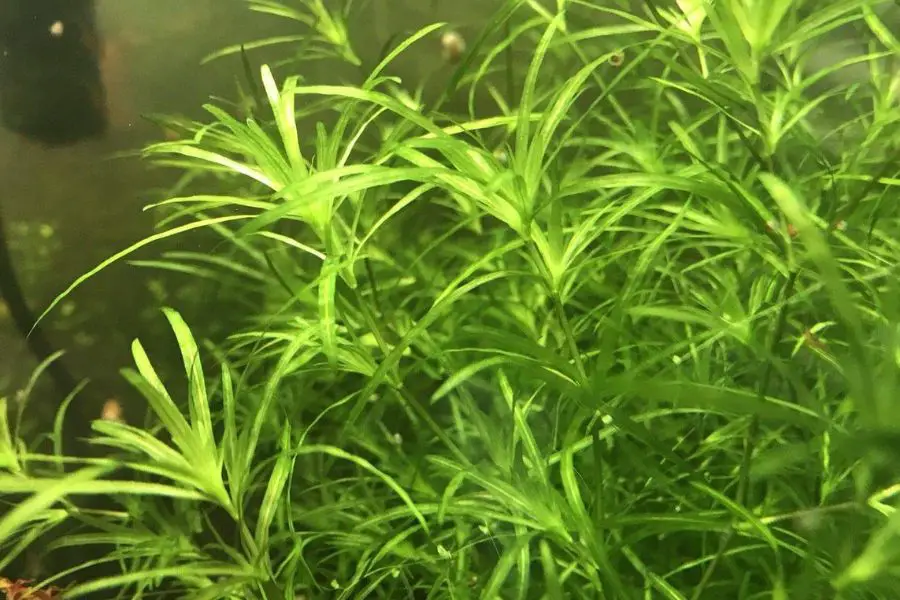Guppy grass, also known as Najas guadalupensis, is a popular aquarium plant known for its attractive light green foliage and ability to grow rapidly.

When provided with proper care and conditions, guppy grass can quickly carpet your tank, providing shelter for fry and small fish as well as removing excess nutrients from the water.
If you’re looking for advice to help your guppy grass flourish, follow these key tips:
Choose the Right Planting Location
Jump To
- Guppy grass thrives when planted in nutrient-rich substrate. Sand or fine gravel is ideal.
- It benefits from high light conditions. Plant in well-lit spaces near the water surface.
- Provide ample room to spread. Don’t cram it in among other plants initially.
- Plant in clusters for fuller growth rather than individual stems. Groups of 3-5 is ideal.
- Prioritize horizontal space over height to encourage spreading root systems.
Provide Proper Tank Conditions
- Warm water between 70-82°F stimulates fast growth.
- Soft to moderately hard water supports healthier plants.
- An iron-rich fertilizer or substrate boosts green color.
- CO2 injection significantly accelerates growth but not essential.
- Gentle water flow across leaves distributes nutrients.
- Avoid aggressive fish that may uproot or nibble new growth.
Start With Healthy Plants
- Select specimens with straight, intact stems and robust roots.
- Look for established plants vs bare cuttings to reduce melt-off.
- Watch for signs of deficiency like yellowing, browning, or wilting.
- Quarantine new plants before adding to avoid transferring disease.
- Remove decaying sections that can compromise healthy growth.
Maintain Steady Growth
- Trim aggressively and often. Frequent pruning spurs dense regrowth.
- Replant trimmings to expand your guppy grass footprint.
- Remove sections that lose bottom leaves or become ratty.
- Dose flourish or comprehensive plant supplements weekly.
- Reduce photo-period to 6-8 hours daily if growth gets excessive.
Fix Potential Issues
- Spot treat algae outbreaks rapidly on leaves.
- Identify and remedy nutrient deficiencies early.
- Reduce light intensity or duration if leaves bleach.
- Improve water circulation to affected areas.
- Rule out pests damaging roots or leaves.
With minimal effort, guppy grass can transform into a cascading green oasis for your aquarium. Just provide bright light, rich nutrients, warm water, and frequent pruning and your grass will blanket your tank in no time!
Your Questions Answered:
Is guppy grass fully aquatic?
Yes,it is a true aquatic plant. All parts can remain fully submerged indefinitely. It does not require dry periods.
Does guppy grass need CO2 injection?
While a CO2 system significantly accelerates growth, it can still grow without supplemented CO2. Proper light and nutrients are more critical.
How fast does guppy grass grow?
With optimal conditions, it can expand to fill a tank in just 1-2 weeks. Expect vertical growth up to 3 inches per week. Pruning generates bushier regrowth.
Will guppy grass outcompete other plants?
Its rapid spread can shade and choke out slower-growing plants. Allow plenty of space or use dividing features to contain its spread.
Is guppy grass suitable for shrimp tanks?
Yes, shrimp enjoy grazing on the foliage and hiding within its dense stands. Just provide additional plant variety for interest.
What’s the best way to plant guppy grass?
Start with clusters of 3-5 stems pushed into the substrate horizontally to take root. Allow space between clusters to fill in.
A little specialized care transforms guppy grass into a showstopper in aquascapes. With its rapid vertical and horizontal growth, you’ll be able to create a lush underwater jungle for your fish in no time!
Read Next:
How To Keep Floating Plants In One Place In The Aquarium
Do Fish Like Heavily Planted Tanks? – An Expert’s Take
Can Dying Aquarium Plants be Harmful to Fish? Exploring the Risks
